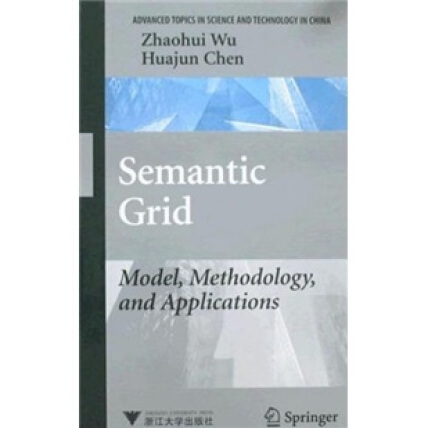
语义网格:模型方法和运用(英文版)
陈华钧 吴朝晖
- I Introduction
- 1.1 Background
- 1.1.1 Grid Computing
- 1.1.2 Semantic Web
- 1.2 Semantic Grid
- 1.2.1 Basic Concepts
- 1.2.2 Brief History
- 1.3 Basic Issues
- 1.3.1 Knowledge Representation for the Semantic Grid
- 1.3.2 Semantic Data Integration
- 1.3.3 Semantic Service Composition and ProcessCoordination
- 1.3.5 Trust and Security
- 1.4 Case Studies
- 1.4.1 myGrid
- 1.4.2 CombeChem
- 1.4.3 CoAKTinG
- 1.4.4 K-WF Grid
- 1.4.5 Semantic Grid Research and Development in China...
- 2.1 Introduction
- 2.2 Knowledge Representation
- 2.2.1 Mathematical Logic
- 2.2.2 Semantic Network
- 2.2.3 Frames
- 2.2.4 Ontology
- 2.3 Description Logic
- 2.4.1 XML and XML Schema
- 2.4.2 RDF and RDF Schema
- 2.4.3 Web Ontology Language
- 2.5 Ontology Development and Application for TCM
- 2.5.1 Ontology Design and Development for UTCMLS
- 2.5.2 TCM Ontology
- 2.6 Summary and Conclusion References
- 3 Dynamic Problem Solving in the Semantic Grid
- 3.1 Introduction
- 3.1.1 Problem Solving
- 3.1.2 Cooperative Distributed Problem Solving
- 3.1.3 Multi-Agent System
- 3.2 Grid-based Problem Solving
- 3.2.1 Grid and Problem Solving
- 3.2.2 Problem Solving in the Semantic Grid
- 3.3 Ontology Management for Grid-based Problem Solving
- 3.3.1 Grid-based Ontology Management
- 3.3.2 Ontology Grid Node
- 3.3.3 Semantic View
- 3.4 Ontology Reuse for Grid-based Problem Solving
- 3.4.1 Dynamic Memory Model
- 3.4.2 Case-based Ontology Repository
- 3.5 Dynamic Problem Solving Based on SubO Evolution
- 3.5.1 Sub-Ontology Manipulations
- 3.5.2 Terminology
- 3.5.3 Problem-Solving Environment
- 3.5.4 Sub-Ontology Based Problem Solving
- 3.7 Related Works
- 3.8 Summary and Conclusion References
- 4 Trust Computing in the Semantic Grid
- 4.1 Introduction
- 4.2 Trust for the Semantic Grid
- 4.2.1 Characteristic Features of Trust
- 4.2.2 Cost and Utility
- 4.2.3 Distributed vs. Centralized
- 4.2.4 Semantics of Information
- 4.3 Closed Trust Model
- 4.4 Open Trust Model
- 4.5 Experiments
- 4.6 Related Work
- 4.7 Summary and Conclusion References
- Data Integration in the Semantic Grid
- 5.1 Introduction
- 5.1.1 Related Work
- 5.1.2 Preliminaries
- 5.2 Semantic Mapping in the Semantic Grid
- 5.2.1 The Mapping Issue
- 5.2.2 Basic Mapping System
- 5.2.3 Constraint Mapping
- 5.3 Semantic Query Processing in the Semantic Grid
- 5.3.1 Answering Queries Using SHIQ-RDM Views
- 5.3.2 Rewriting SPARQL Queries Using SHIQ-RDM Views
- 5.4 Summary and Conclusion References
- Service Flow Management in the Semantic Grid
- 6.1 Introduction
- 6.2 Research Framework of Service Flow Management
- 6.2.1 Service Matchmaking and Discovery 128,
- 6.2.2 Service Composition
- 6.2.3 Service Composition Verification
- 6.3 Service Matchmaking in DartFlow
- 6.3.1 An Extended Service Model
- 6,3.2 Service Matchmaking
- 6,3.3 Performance Evaluation
- 6.4 Service Composition in DartFlow
- 6,4.1 Service Composition Framework
- 6,4.2 Rules Types and Definitions
- 6,4.3 Automatic Service Composition Based on Rules
- 6.5 Service Flow Verification in DartFlow
- 6.5.1 Overview of π-Calculus
- 6.5.2 Modeling Service Behavior Using π-Calculus
- 6.5.3 Verification of Service Compatibility
- 6.6 Summary and Conclusion References
- Data Mining and Knowledge Discovery in the SemanticGrid
- 7.1 Introduction
- 7.2 Development of KDD System Architecture
- 7.2.1 Single-computer-based Architecture
- 7.2.2 Parallelized Architecture
- 7.2.3 Distributed Architecture
- 7.2.4 Grid-based Architecture
- 7.3 Knowledge Discovery Based on the Semantic Grid
- 7.4 Drug Community Discovery Utilizing TCM Semantic Grid...
- 7.4.1 Semantic Graph Mining Methodology
- 7.5 Summary and Conclusion References
- DartGrid: A Semantic Grid Implementation
- 8.1 Introduction
- 8.2 DartDB-A Semantic Data Integration Toolkit
- 8.2.1 Overview
- 8.2.2 System Features
- 8.2.3 System Architecture
- 8.2.4 Mapping from Relational Data to Semantic WebOntology
- 8.2.5 Semantic Browser and Query Tool
- 8.2.6 Semantic Search Engine
- 8.3 DartFlow-A Service Flow Management Prototype
- 8.3.1 Overview
- 8.3.2 System Architecture
- 8.3.3 Main Functions
- 8.4 Summary and Conclusion
- 9.1 Background, Status, and Problems of TCM Informatics
- 9.1.1 Background of TCM Informatics
- 9.1.2 Status of TCM Informatics